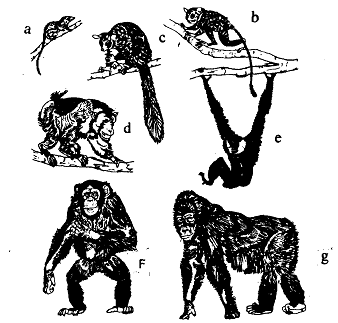Primate Heritage:
Man belongs to a group of animals called mammals which are different from other animal groups in possessing hair, and milk producing mammary glands, among other things. Mammals can be further divided into smaller groups or 'orders' on the basis of 4fferences within the group. 'Primates', the order to which man belongs, alongwith apes and monkeys, were active during the night, that is, they were nocturnal in the beginning of their evolution. These animals were insect-eaters and lived on trees. This combination of feeding on insects, while being suspended on branches and

twigs, led the primates to develop some important adaptations. The hand, underwent several changes. The thumb became opposable, that is, it closes to meet the finger tips which aided in holding the prey. Sensitive fingers developed, having nails rather than claws. Eye sockets were shifted to the front of the head, providing the primates a better vision and keen ability for judging distance. These striking adaptations in the primates gave rise to large sized forms, which adopted a diurnal life style, i.e. they were active during the day. Their diet included plant food like leaves and fruits. The origin of monkeys and apes took these adaptations to even higher levels. Possession of sensitive finger tips became of even greater importance, as the ripeness of fruits could be judged better by touch than by sight. Apes move beneath the branches, suspended by long agile arms rather than walking along them. This involves a relatively upright posture, and their hips became a part of this kind of movement. Even when they move on the ground, apes ockasionally walk as bipeds, i.e., on two feet. It may be an awkward walk with short steps and swaying motion, but it is two footed. nonetheless. Changes in the skull and back~bone help in the upright posture. And the way the heart, lungs and other body organs are suspended in the abdomen differs from that of conventionally four footed animals.